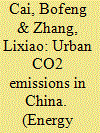| Srl | Item |
| 1 |
ID:
117320


|
|
|
|
|
| Publication |
2013.
|
| Summary/Abstract |
Urban areas are recognised to be significant global energy consumers, and therefore high CO2 emitters, making energy management at urban scales a relevant research focus. However, one of the main obstacles faced with upgrading existing urban systems to meet target energy reductions is the current rate of refurbishment and new build, where it is estimated that 75% of existing buildings will still be in place by 2050. Moreover limited renewable resources and predicted warming trends place further limitations on policies aimed at carbon management. This paper examines current thinking around energy management associated with building operational and regulated loads and the role of urban form. Its focus is on cooling loads for office buildings in central London and offers a new perspective on energy management at an urban scale by demonstrating (within the 25% redevelopment rate) that when building energy management is considered within an urban context, the overall performance of an urban system can be significantly improved. The work highlights the often overlooked role of urban form on building energy performance (both individually and in combination) and demonstrates that as we move towards a low energy future; the role of urban form becomes increasing significant.
|
|
|
|
|
|
|
|
|
|
|
|
|
|
|
|
| 2 |
ID:
128033


|
|
|
|
|
| Publication |
2014.
|
| Summary/Abstract |
Different names/concepts and therefore different spatial boundaries for cities in China are responsible for the conflicting and confusing results associated with urban CO2 emissions accounting. In this study, four types of urban boundaries, i.e., city administrative boundary (UB1), city district boundary (UB2), city built-up area (UB3) and urban proper (UB4), were identified and defined. Tianjin was subsequently selected as the case city to illustrate the different performances of CO2 emissions with respect to these four boundaries using a 1-km grid dataset built bottom-up by point-emission sources. Different urban boundaries can induce a difference in CO2 emissions as large as 654%. UB1 and UB2 are not the appropriate proxies for urban boundaries in the analysis of urban CO2 emissions, although UB1 is a widely adopted boundary. UB3 is a good representative of city clusters and urban sprawl in a certain region, whereas UB4 is the appropriate system boundary for such issues as urban CO2 emissions in light of landscape characteristics and pertinent human activities, as well as the comparability to counterparts in developed countries. These results provide sound policy implications for the improvement of urban energy management and carbon emission abatement in China.
|
|
|
|
|
|
|
|
|
|
|
|
|
|
|
|